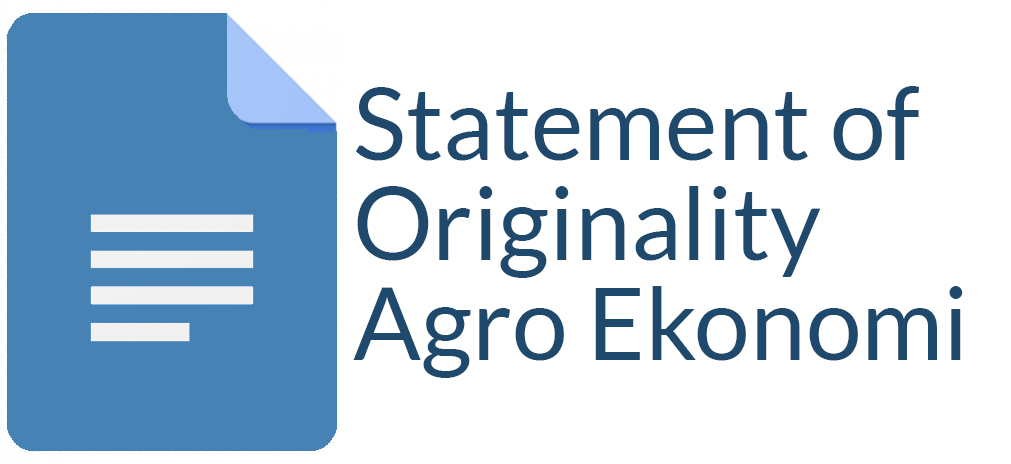Determinants of Willingness-to-Pay A Premium Price for Integrated Pest Management Produced Fruits and Vegetables in Trinidad
G Kathiravan(1*), Saravanakumar Duraisamy(2), Ataharul Chowdhury(3), Wayne Ganpat(4)
(1) Tamil Nadu Veterinary and Animal Sciences University
(2) Professor, Department of Food Production, FFA, The UWI, St. Augustine, Republic of Trinidad and Tobago
(3) Assistant Professor, School of Environmental Design & Rural Development, University of Guelph, Guelph, Ontario
(4) Dean, Faculty of Food and Agriculture, The UWI, St. Augustine, Republic of Trinidad and Tobago, WI
(*) Corresponding Author
Abstract
Keywords
Full Text:
PDFReferences
Alston, J.M. (2018). Reflections on agricultural R&D, productivity, and the data constraint: Unfinished business, unsettled issues. American Journal of Agricultural Economics, 100(2), 392413.
Akter, M., Fan, L., Rahman, M.M., Geissen, V., & Ritsema, C.J. (2018). Vegetable farmers behaviour and knowledge related to pesticide use and related health problems: A case study from Bangladesh. Journal of Cleaner Production, 200, 122-133.
Bonner, M.R., & Alavanja, M.C.R. (2017). Pesticides, human health, and food security. Food and Energy Security, 6(3), 89-93.
Caroline, D. (2012). Evaluating Best Practices Examples of Integrated Pest Management Solutions on Farms. Outlooks on Pest Management, 23 (4), 189-193.
Chowdhury, A., Odame, H.H., Thompson, S., & Hauser, M. (2015). Enhancing farmers' capacity for botanical pesticide innovation through video-mediated learning in Bangladesh. International Journal of Agricultural Sustainability, 13(4), 326-349.
Ganpat, W., Kathiravan, G., & Dalrymple, J. (2018). Use of Food Label Information by Trinidad Consumers and Implications for National Health. Journal of Agricultural & Food Information, 19(2), 121-128.
Harris, L., Norton, G.W., Rezaul Karim, A.N.M., Alwang, J., & Taylor, D.B. (2013). Bridging the information gap with cost-effective dissemination strategies: the case of integrated pest management in Bangladesh. Journal of Agricultural and Applied Economics, 45, 639654.
Hashemi, S.M., & Damalas, C.A. (2011). Farmers' Perceptions of Pesticide Efficacy: Reflections on the Importance of Pest Management Practices Adoption. Journal of Sustainable Agriculture, 35(1), 69-85.
Jørs, E., Aramayo, A., Huici, O., Konradsen, F., & Gulis, G. (2017). Obstacles and opportunities for diffusion of integrated pest management strategies reported by Bolivian small-scale farmers and agronomists. Environmental Health Insights, 11, 1-14.
Kim, K.H., Kabir, E., & Jahan, S.A. (2017). Exposure to pesticides and the associated human health effects. Science of the Total Environment, 575, 525-535.
Kiruthika, N., & Selvaraj, K.N. (2013). An economic analysis of consumer preference towards pest management (IPM) produce. Journal of Environmental Research and Development, 7(4A), 1684-1692.
Larochelle, C., Alwang, J., Travis, E., Barrera, V.H., & Dominguez, J.M. (2017). Did you really get the message? Using text reminders to stimulate adoption of agricultural technologies. The Journal of Development Studies, 55, 548564.
Mengistie, B.T., Mol, A.P.J., Oosterveer, P., & Simane, B. (2014). Information, motivation and resources: The missing elements in agricultural pesticide policy implementation in Ethiopia. International Journal of Agricultural Sustainability, 13(3), 240-256.
MFPLMA. (2011). Strategic Plan 2011-2015. Ministry of Food Production, Land and Marine Affairs, Government of Trinidad and Tobago.
Obayelu, O., Agboyinu, O., & Awotide, B. (2014). Consumers perception and willingness to pay for organic leafy vegetables in urban Oyo State, Nigeria. European Journal of Nutrition & Food Safety, 4(2), 127-136.
Popp, J., Pető, K., & Nagy, J. (2013). Pesticide productivity and food security. A review. Agronomy for Sustainable Development, 33(1), 243-255.
Pretty, J., & Bharucha, Z. P. (2015). Integrated Pest Management for Sustainable Intensification of Agriculture in Asia and Africa. Insects, 6(1), 152182. https://doi.org/10.3390/insects6010152
Priyadharsini, S., Kathiravan, G., Thirunavukkarasu, M., Ganpat, W., & Saravanakumar, D. (2017). Ordered Probit Analysis of Consumers Preferences for Milk and Meat Quality Attributes in the Emerging Cities of Southern India. Expert Journal of Marketing, 25(2), 37-43.
Puduri, V.S., Govindasamy, R., Myers, J.J., & ODierno, L.J. (2011). Consumer attitude towards pricing of live aquatic products. Aquaculture Economics & Management, 15(2), 118-129.
Saravanakumar, D., Hanel, A., Thomas, A., Ramnanan, N., & Seepersad, G. (2016). Major diseases affecting christophene production in Trinidad. In: International Conference on Integrated Disease Management in Tropical Vegetables from 16-17th, 2016 at The University of the West Indies, St. Augustine, Trinidad.
Savary, S., Horgan, F., Willocquet, L., & Heong, K.L. (2012). A review of principles for sustainable pest management in rice. Crop Protection, 32, 54-63.
Schut, M., Rodenburg, J., Klerkx, L., Van-Ast, A., & Bastiaans, L. (2014). Systems approaches to innovation in crop protection: A systematic literature review. Crop Protection, 56, 98108.
Toleubayev, K., Jansen, K., Van-Huis, A. (2011). From Integrated Pest Management to Indiscriminate Pesticide Use in Kazakhstan. Journal of Sustainable Agriculture, 35(4): 350-375.
Tuz, Z.F. (2018). Educating farmers to be environmentally sustainable: knowledge, skills and farmer productivity in rural Bangladesh. Publicly Accessible Penn Dissertations. 3002.
https://repository.upenn.edu/edissertations/3002
Vijay, K.K., Sharma, S.K., & Sanjay, K. (2010). Environment friendly system of cropping. Journal of Environmental Research and Development, 5(1), 222-232.
Wynn, J.T., Coppedge, R.H., & Strong, R. (2011). Future IPM Trends in Trinidad and Tobago: A Qualitative Study of Farmers Perspectives. Journal of International Agricultural and Extension Education, 20(2), 65-76
Article Metrics
Refbacks
- There are currently no refbacks.
Copyright (c) 2018 Agro Ekonomi

This work is licensed under a Creative Commons Attribution-ShareAlike 4.0 International License.
View My Stats












